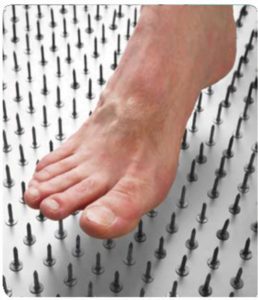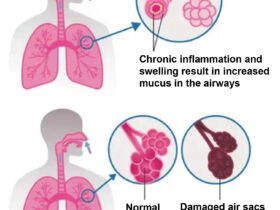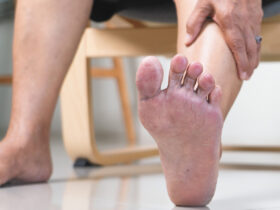 Many of our patients with Neuropathy report that their feet or hands feel just like the picture on the right. Peripheral Neuropathy is a condition affecting more than 30 million Americans, and the condition is growing rapidly.
Many of our patients with Neuropathy report that their feet or hands feel just like the picture on the right. Peripheral Neuropathy is a condition affecting more than 30 million Americans, and the condition is growing rapidly.
In our clinics across the country, we have developed a precise and effective system treating peripheral Neuropathy. This program is helping thousands of people across the US with this debilitating condition.
The interventions and technology we use are designed to address the multiple factors that can contribute to the development of Neuropathy, and provide ongoing relief for our patients.
Given that peripheral Neuropathy almost always has a vascular component, the first group of therapies we utilize are designed to improve nitric oxide production, nerve re-education, angiogenesis, and increase circulation to the extremities.
When we can improve the underlying blood supply to the peripheral nerves as well as address the centrally mediated pain, patients experience substantial decreases in pain, increased balance, and diminished numbness/tingling that is
all too common with Neuropathy.
We have a unique system where you will only have to come in the office lx/week for a period of time, while gaining independence from your Neuropathy condition.
Infrared Diode Photo Therapy
At the forefront of our treatment regimen is the use of an infrared diode device, also known as low-level light therapy, photon therapy or photo therapy. This therapy outputs infrared light ranging in wavelength from 430-880 nm. The best wavelengths to use are infrared, specifically the narrower wavelengths in the near infrared (NIR) band centering around 900 nm. When used appropriately on the affected area, these
lights promote the release of nitric oxide from the endothelial cells, increasing local blood flow, and stimulating angiogenesis.
Nitric oxide is also known to play a critical role in increasing the flow of blood into body tissues. Better blood flow serves to bring fresh nutrients and oxygen into the injured area and remove bacteria and toxins out of it. This therapy has been around for some time now and is well documented and researched. Because of the limited depth of penetration of the light and the limited area that can be treated (only directly under the lights), this therapy is best used when any particular local area has been identified with a loss of local blood perfusion such as on the plantar surface of the foot, a local injury that is slow healing, or the diabetic foot.
By localizing the area to be treated,stimulating the release of nitric oxide, and increasing circulation to the peripheral nervous system, infrared therapy was found in one study to produce a 67% reduction in pain as well as a 66% increase in foot sensation (2).Prendergrast, Miranda, and Sanchez found a decrease in foot pain from an average of 8 on the Visual Analog Scale to 3 following 10 treatment sessions (3). This study also found that 16 of the 27 subjects achieved normal foot sensation.
An important measure of sensory nerve growth following treatment is the patient’s ability to exhibit protective sensation to a Semmes-Weinstein monofilament. A study in the Journal of the American Podiatric Medical Association found that 98% of subjects exhibited improved sensation after 30 days, and 100% showed improvement after 90 days (4).
A well-documented consequence of peripheral Neuropathy is an increase in falls and fear of falling. As peripheral nerve regeneration takes place with our collective treatment system with multiple modalities, one of the results is improved proprioception and balance.
A double-blind, randomized, placebo controlled study published in the Journal Diabetes Care (with the plantar surface of the diabetic foot), found remarkable improvements in balance following a course of infrared therapy. At the beginning of the study, 90% of subjects reported substantial balance improvement; after treatment this declined to only 17%. Another study published in 2006 found a 78% reduction in falls and a 72% increase in activities of daily living (5). The rate of wound incidence in diabetic peripheral neuropathy also dramatically decreased with the administration of this therapy. One study found the rate of new diabetic foot wounds to be 1.5% in the treatment group vs. the national average of 7.3% (6). This results in a substantial cost savings as well as a reduction in patient risk due to wound healing complications. As promising as the results of infrared treatment as a monotherapy may be, we have seen more comprehensive results with the addition of several other therapies.
Nerve Re-Education
Electrical stimulation with the ReBuilder®
Peripheral neuropathy is primarily a nerve problem. The primary tool we use is the ReBuilder, a unique electrical stimulation device that opens the nerve paths, re-educates the nerves, re-mineralizes the synaptic junctions between the nerve cells, and treats all the nerves from the toes, up the leg, across the central nervous system and peripheral nervous system synaptic junctions, and then down the other leg. This device is currently used at The Cancer Treatment Centers of America and has been for more than 15 years exclusively and they have reported a 93 percent success rate in the reduction of both pain and numbness.
In Clinic Therapy & Education
In synergy with your practitioner’s home therapy recommendations, you will be required to complete an In-Clinic Protocol so we are addressing all underlying causes of your condition. In addition, you will have access to our complete Neuropathy Education Curriculum where we will teach you the cause of neuropathy, how to avoid developing neuropathy again, and we will teach you the lifestyle choices that help eliminate your condition for good. This approach has helped over 50,000 patients who suffer from peripheral neuropathy and is becoming the #1 choice to treating neuropathy.
Studies:
1) 551 patients by Rene Hartz, MD, and Rita Wickhan, PH.D. at the Northern Michigan University, published this abstract:” 551 patients were treated with the ReBuilder system, a unique TENS/EMS electrical stimulation device to determine if the quality of life was improved. Fully 91% reported success.
No side effects were reported. The ReBuilder is safe and effective for treating peripheral neuropathy.”
2) 472 patients, self-selected, self-diagnosed, and self-treated (found and ordered the ReBuilder on the internet) with only this single modality, 74% reported immediate relief after their first treatment, average pain drop after any treatment was 40%, 81% reported satisfaction, and only 10% returned their device.
3) 530 patients whose physicians had run out of effective therapies, found the ReBuilder on the internet brought the device to the attention of their MD. These 530 MD’s, unknown to each other, and not advised of the study, prescribed a 60-day rental trial requiring a follow up visit to determine the efficacy of the ReBuilder. All 530 physicians, after re-examining their individual patient 60 days later, ordered the purchase of the device.
The reason the ReBuilder can reduce both pain and numbness (unlike a common TENS that only treats pain and can leave a patient with long term residual numbness) is three-fold, and no other device has these patented features.
1. The device reads the patient’s unique signature dysfunctional waveform, and then uses a computer generated compensating waveform to cancel that asymmetry, (think Bose® noise canceling headphones).
2. 20% of the ReBuilder’s gentle impulses are EMS in nature and stimulate the venous muscle pump in the calves to increase local blood supply. If one is to stimulate the nerves, they will need more fresh blood in and more blood out to take out metabolic toxins.
3. The specific 7.83 frequency of the ReBuilder causes the brain to release endorphins which are internally created pain relievers that travel via the blood stream throughout the body. These endorphins reduce pain in other parts of the body, helps the patient get to sleep, and then sleep all night.
4. The ReBuilder’s proprietary dual function waveform: 80% of its impulses stimulate nerves, while 20% stimulates muscle enhances and maintains the nerve/muscle connection so the patient’s gait is improved (no falling) and muscle cramps are reduced.
5. Accommodation to the impulses are avoided by the ReBuilder use of a patient imperceptible Fibonacci based formula to slightly vary the frequency, pulse width, and intensity.
Your Pain Ends Today!
Free Workshop Call 239-301-2206 to reserve a spot to our upcoming seminar. Spots are limited to 17 guests.









